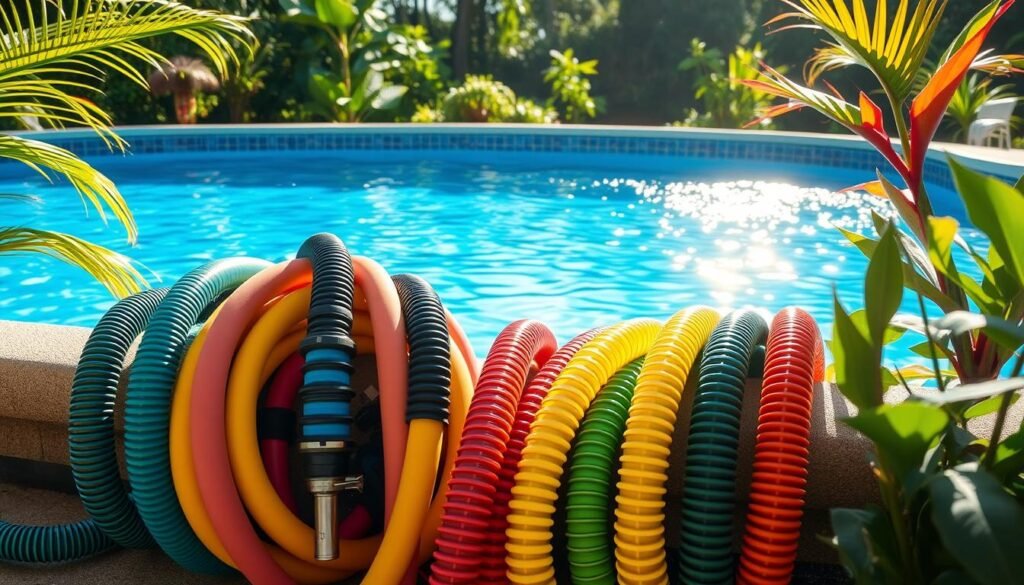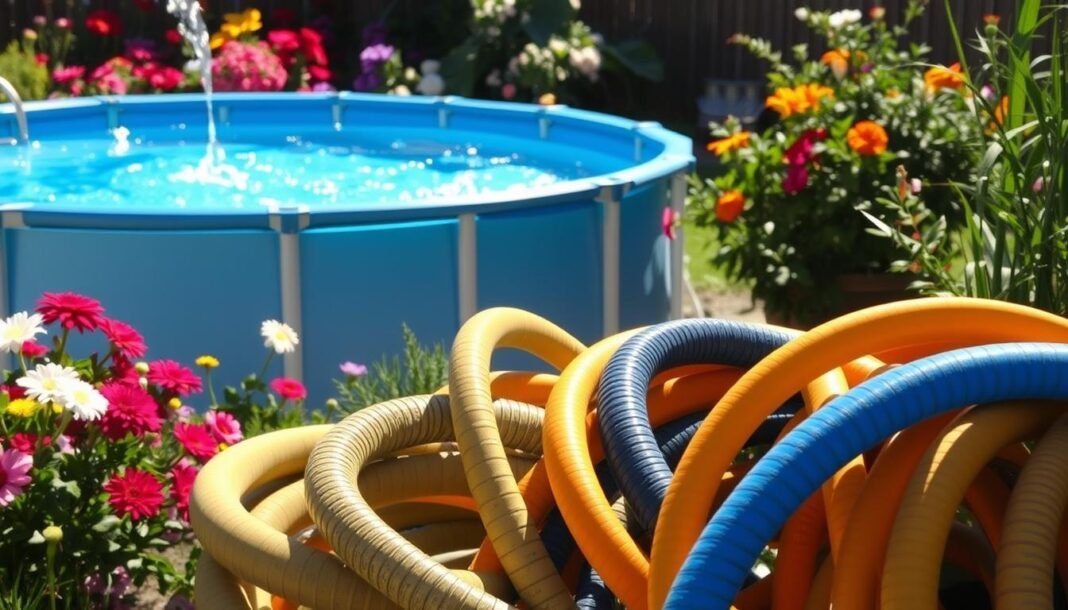Pool owners know maintaining an above ground pool is crucial. It ensures longevity and a refreshing swim all season. The unsung hero of pool functionality is the pool hose.
Pool hoses are vital for circulating water and filtering impurities. They keep your pool sparkling clean. This guide will explore above ground pool hoses in depth.
You’ll gain knowledge to make informed decisions about your pool. We’ll help you keep your oasis running at its best.
Key Takeaways
- Discover the importance of above ground pool hoses in maintaining water quality and flow
- Understand the different types of pool water circulation systems and how hoses integrate with them
- Learn about the essential components of pool plumbing systems and how to choose the right hoses
- Gain insights into proper installation, maintenance, and troubleshooting of pool hoses
- Explore seasonal care and storage tips to extend the lifespan of your pool cleaner hoses
Understanding Above Ground Pool Hoses and Their Importance
Pool hoses are crucial for clean and efficient above ground pool systems. They impact the functionality and water quality of your pool. Let’s explore pool hoses and their role in pool water pumps and equipment plumbing.
Types of Pool Water Circulation Systems
Above ground pools use two main water circulation systems: suction-side and pressure-side. Suction-side systems draw water from the pool through the skimmer. Pressure-side systems push water back into the pool, often through a return line.
The quality and condition of pool hoses directly affect these systems’ performance and efficiency.
Role of Hoses in Pool Functionality
Pool hoses transport water from the pump to the filter and back. Their diameter, length, and material impact water flow rate and filtration. Properly selected and maintained hoses ensure efficient water circulation, promoting optimal pool functionality.
Impact on Water Quality and Flow
Pool hose condition significantly affects water quality and flow. Damaged or clogged hoses can restrict flow, leading to poor circulation and decreased filtration. This can cause cloudy water and uneven chemical distribution.
High-quality, flexible hoses from manufacturers like Terraflex Industries are essential. They keep your pool water clean, clear, and circulating effectively.
| Pool Water Circulation System | Hose Considerations |
|---|---|
| Suction-side | Diameter, length, and material impact water flow from pool to pump |
| Pressure-side | Hose quality affects water pressure and distribution back into the pool |
Different Types of Above Ground Pool Hoses
Pool filter hoses and flexible pool tubing are vital for above ground pools. They ensure clean water by aiding circulation and filtration. Let’s look at various types of above ground pool hoses.
The filter hose is a common type. It moves water between the pool and filter system. These hoses are made of tough, flexible materials to handle filtration demands.
The return hose is another key component. It brings filtered water back to the pool. These hoses distribute water evenly and manage the required flow and pressure.
- Pool vacuum hoses work with cleaning equipment. They’re built to handle suction and abrasion from pool cleaning.
- Pool filter hoses are often made from PVC, polyethylene, or reinforced rubber. These materials provide strength, flexibility, and durability.
Choosing the right hoses impacts your pool’s efficiency. It also affects the longevity of your water circulation system. Understanding each hose type helps you make smart choices.
The right hoses can optimize your pool’s performance. This ensures a better swimming experience for everyone.
Essential Components of Pool Plumbing Systems
A well-functioning aboveground pool needs a solid plumbing system. Key elements include connection points, fittings, valve types, and pressure ratings. These parts ensure your pool equipment plumbing runs smoothly and efficiently.
Connection Points and Fittings
Your pool’s plumbing system relies on a network of connection points and fittings. These parts help water flow properly throughout the system.
Key components include skimmer and return jets, pump lines, and filter connections. Flexible hoses and rigid pipes also play important roles.
Tight, secure fits for these aboveground pool parts are crucial. They maintain good water circulation and prevent leaks.
Valve Types and Their Functions
Valves control water flow in your pool’s plumbing system. They come in different types, each with a specific purpose.
- Ball valves – Used for on/off control and flow regulation
- Diverter valves – Allow water to be directed to multiple destinations
- Check valves – Prevent backflow and maintain proper water pressure
Choosing the right valves and placing them correctly is vital. It impacts your pool equipment plumbing’s efficiency and performance.
Pressure Ratings and Requirements
Knowing the right pressure ratings for your pool’s plumbing parts is essential. Factors like pump size and filter type affect required pressure specs.
Using aboveground pool parts that can handle needed pressure levels is important. This prevents leaks, improves water flow, and extends equipment life.
| Component | Typical Pressure Range |
|---|---|
| Pump | 20-40 PSI |
| Filter | 10-25 PSI |
| Hoses and Pipes | 30-50 PSI |
Understanding these pool plumbing basics helps you maintain your system better. You’ll be able to troubleshoot issues and keep your aboveground pool running smoothly.
Choosing the Right Pool Filter Hoses for Your Setup
Pool filter hoses are crucial for a clean, above-ground pool. They ensure your filtration system works well, keeping your water crystal clear. These swimming pool accessories are essential for maintaining a sparkling pool.
Consider these key factors when selecting pool filter hoses:
- Size – Measure your pool equipment connections. Choose hoses with the right diameter for a secure fit.
- Material – Pick durable, pool-safe materials. Reinforced PVC or flexible polyethylene can withstand chemicals and weather.
- Flexibility – Select hoses that bend easily. This helps them fit around your pool equipment.
- Compatibility – Make sure the hoses work with your current pool pump and filter. This ensures smooth integration.
The right pool filter hoses can boost your filtration system’s performance. This helps maintain top-notch water quality for your family.
Careful selection of hoses optimizes your pool’s filtration. It’s an important step in keeping your pool clean and enjoyable.

| Hose Characteristic | Recommended Criteria |
|---|---|
| Diameter | Match existing equipment connections |
| Material | Reinforced PVC or flexible polyethylene |
| Flexibility | Easily bendable and maneuverable |
| Compatibility | Ensure fit with pump, filter, and other components |
Installation Guide for Pool Equipment Plumbing
Installing pool equipment plumbing correctly is vital for your aboveground pool’s safe operation. This guide covers tools, instructions, and common mistakes to avoid.
Tools Required for Installation
Get these tools ready before starting your pool equipment plumbing project:
- Teflon tape or pipe sealant
- Adjustable wrenches
- PVC pipe cutter or saw
- Hacksaw or pipe cutter
- Drill with appropriate bits
- Level
- Measuring tape
Step-by-Step Installation Process
Follow these steps to install your pool equipment plumbing:
- Measure and cut the pool equipment plumbing to fit snugly.
- Apply Teflon tape or pipe sealant to threaded connections for a watertight seal.
- Connect aboveground pool parts like the pump, filter, and skimmer.
- Use a level to ensure proper plumbing installation for optimal water flow.
- Secure the plumbing with appropriate fasteners or supports.
- Test the system by turning on the pump and checking for leaks.
Common Installation Mistakes to Avoid
Be aware of these common pitfalls when installing pool equipment plumbing:
- Incorrect measurement and cutting of pool equipment plumbing
- Forgetting Teflon tape or pipe sealant on threaded connections
- Poor alignment or support of plumbing components
- Overtightening connections, risking cracks or damage
- Skipping system testing before finishing installation
Proper installation ensures efficient water flow and reduces leak risks. Follow this guide to set up your pool equipment plumbing correctly.
Maintenance Tips for Pool Vacuum Hoses
Proper care of pool vacuum hoses is vital for top performance. Regular maintenance extends their life and saves money. Here are key tips to keep your pool vacuum hoses in great shape.
Cleaning and Inspection
Clean your pool vacuum hoses often to remove debris and algae. Disconnect and rinse them with a garden hose. Let them air dry before reattaching.
Check hoses for cracks, holes, or wear. Replace them if you spot any damage.
Storage and Protection
Store pool vacuum hoses in a cool, dry place away from sunlight. Coil them loosely to avoid kinks and damage.
Consider getting pool maintenance supplies like hose reels or storage bags. These keep hoses organized and safe.
Winterizing Precautions
Winterize your pool vacuum hoses before cold weather hits. Drain water, disconnect hoses, and store them in a protected area.
Proper winterization prevents freeze damage. It ensures your hoses are ready for the next pool season.
These tips help extend your pool vacuum hoses‘ life. They keep your pool running smoothly all season. Regular care with pool maintenance supplies prevents costly replacements later.

Troubleshooting Common Pool Hose Issues
Keeping your pool’s water circulation system in top shape is vital. Sometimes, issues arise with pool cleaner hoses and pool maintenance supplies. Let’s look at how to spot and fix common pool hose problems.
We’ll cover quick fixes and when to replace your hoses. This guide will help you maintain a clean, well-functioning pool all season long.
Identifying Leaks and Damage
Hose problems can disrupt water flow and filtration. Look for visible cracks, holes, or worn spots on your hoses. Listen for unusual noises or gurgling sounds.
These signs might indicate a leak in your system. Regular checks can help catch issues early.
Emergency Repair Solutions
- For small holes or cracks, use a pool hose repair clamp or kit to seal the issue.
- If the hose is kinked or tangled, carefully straighten it out or use a hose reel.
- For major leaks, temporarily replace the affected hose section until you find a permanent fix.
When to Replace Pool Hoses
Pool hoses typically last 2-3 years. Replace them sooner if you notice significant wear and tear. Watch for these signs:
- Severe cracking or brittleness in the hose material
- Constant leaks or damage that can’t be effectively repaired
- Reduced water flow or pressure due to internal buildup or blockages
Addressing hose issues quickly keeps your pool’s water circulation efficient. This ensures a safe, fun swimming experience throughout the season.
Seasonal Care and Storage of Pool Cleaner Hoses
Proper care of pool cleaner hoses is vital for your swimming pool system. Protect your hoses from damage to keep them working well. Prepare and store them correctly as seasons change.
When winterizing, disconnect and drain your pool cleaner hoses completely. This stops water from freezing and damaging the material. Store hoses in a cool, dry place away from sunlight.
Proper storage keeps hoses flexible for next season. Before pool season, check hoses for wear or damage. Look for cracks, splits, or brittleness in the material.
Replace any hoses that aren’t in top shape. Well-maintained hoses perform better and improve water quality. They also boost the efficiency of your swimming pool accessories.
